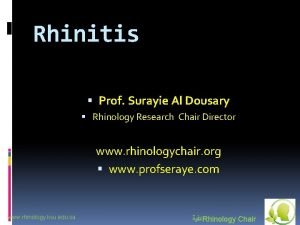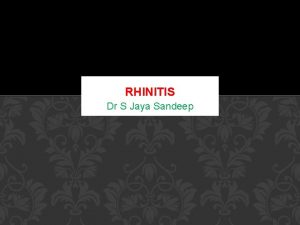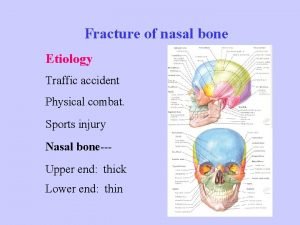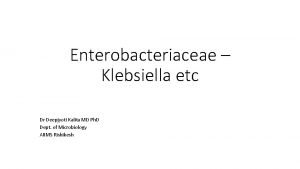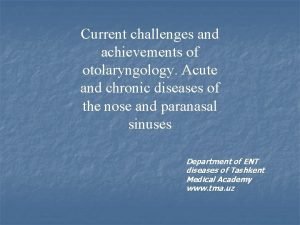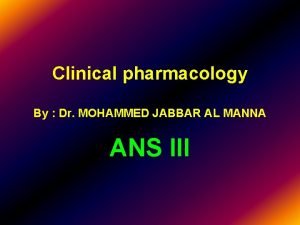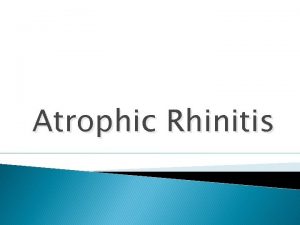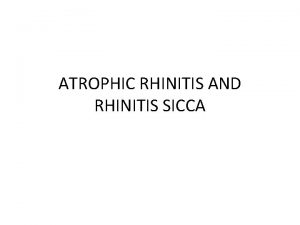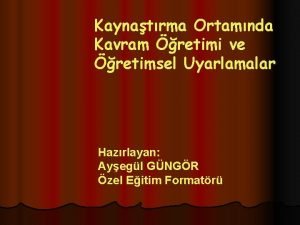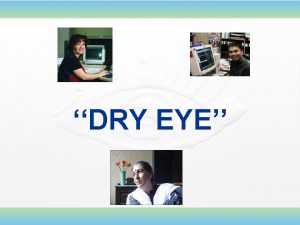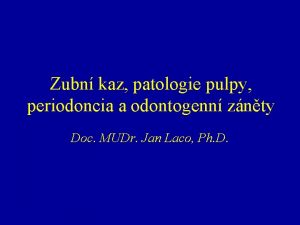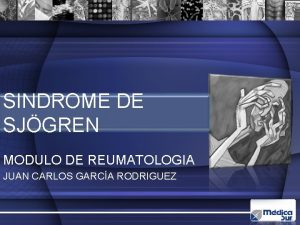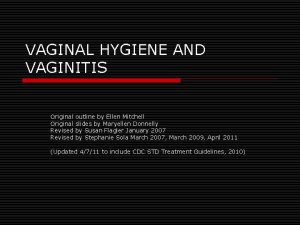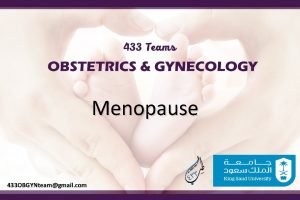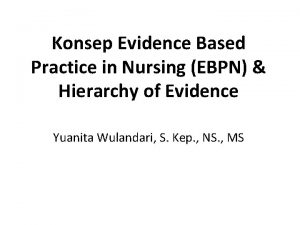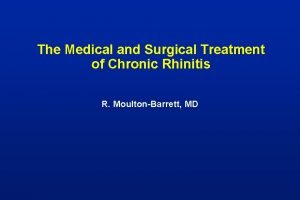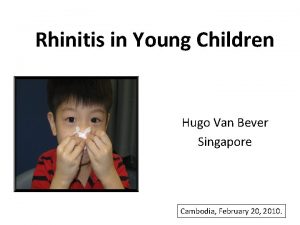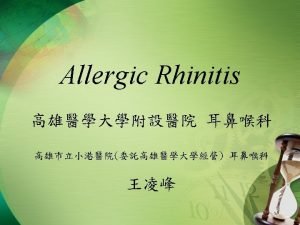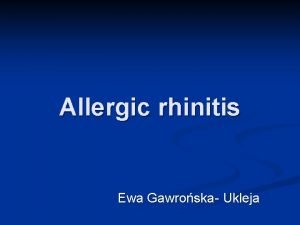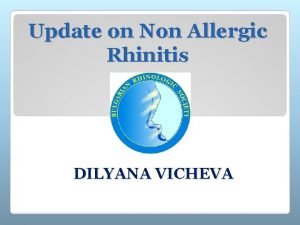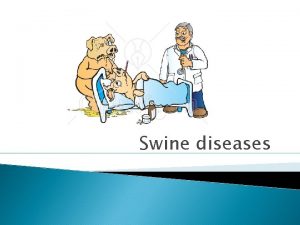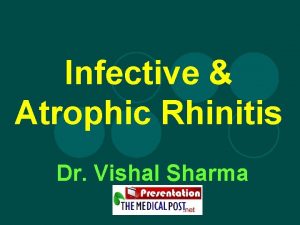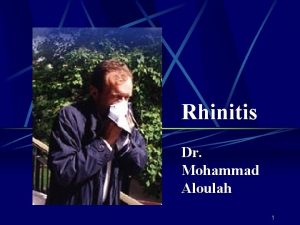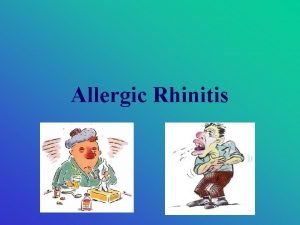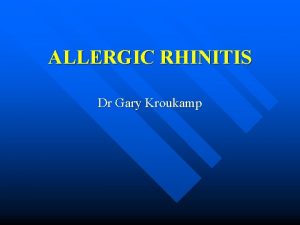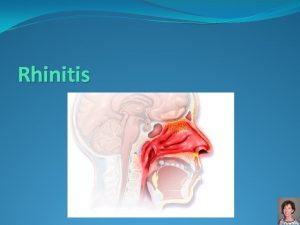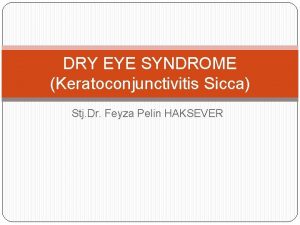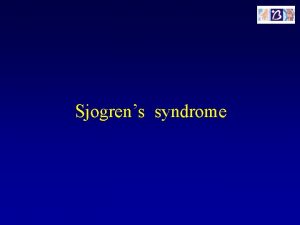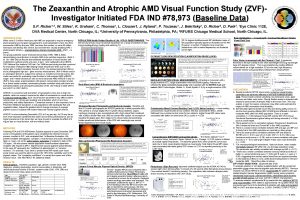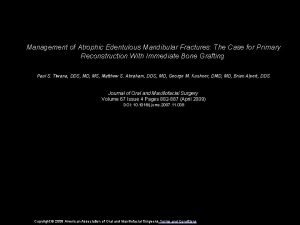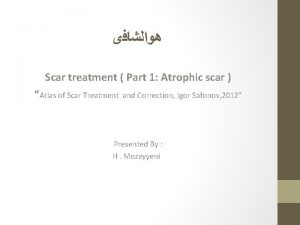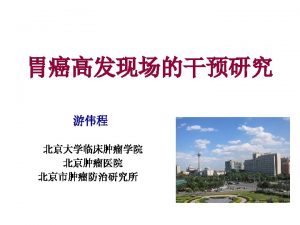ATROPHIC RHINITIS AND RHINITIS SICCA Levels of Evidence
































- Slides: 32

ATROPHIC RHINITIS AND RHINITIS SICCA

Levels of Evidence • Grade A – Systemic reviews, Meta analyses, RCT • Grade B – Non-randomized studies • Grade C – Observational studies • Grade D – Case Series, Expert opinion

Levels of Evidence **** ~ Systematic reviews, meta analysis of randomized control studies *** ~ Non randomised studies ** ~ Observational or non experimental studies * ~ Expert opinion

ATROPHIC RHINITIS • Described in 1876 by Dr. Bernhard Fraenkel as a triad of: – Fetor – Crusting – Atrophy of nasal structures • Dr. Francke Bosworth. A Manual of Diseases of the Nose and Throat. 1881. – “the breath is often so penetrating as to render the near presence of the sufferer not only unpleasant but almost unendurable. ”

ATROPHIC RHINITIS • It is a chronic inflammation of nose characterized by atrophy of nasal mucosa and turbinate bones • The nasal cavities are roomy and full of foul smelling crusts

Atrophic rhinitis primary secondary

PRIMARY Aetiology: • Hereditary factors • Endocrinal disturbance • Racial factors • Nutritional deficiencies • Infective

Secondary AR: Complication of sinus surgery Complication of radiation Following nasal trauma Sequela of granulomatous diseases and other infections : TB, Sarcoidosis, Leprosy, Rhinoscleroma, Syphilis

PATHOLOGY �Ciliated columnar epithelium is lost and is replaced by stratified squamous type �There is atrophy of seromucinous glands, venous blood sinusoids and nerve elements �Arteries in the mucosa, periostium and bones show obliterative endarteritis �The bone of turbinates under goes resorption causing widening of nasal chamber

CLINICAL FEATURES – Anosmia – Ozena, i. e. foul odor – Extensive nasal crusting – Subjective nasal congestion – Enlargement of the nasal cavity – Resorption or absence of turbinates – Squamous metaplasia of nasal mucosa – Depression

Radiographic Findings 1. Enlargement of the nasal cavities with erosion and bowing of the lateral nasal wall. 2. Bony resorption and mucosal atrophy of the inferior and middle turbinates.

MICROSCOPIC PICTURE • Normal Mucosa – Pseudostratified Columnar – Presence of serous and mucous glands • Atrophic Rhinitis – Squamous metaplasia – Atrophy of mucous glands – Scarce or absent cilia – Endarteritis obliterans

Microbiology • Klebsiella ozenae – May be found in almost 100% of primary AR – No predominance in secondary AR • • Staphylococcus aureus Proteus mirabilis Escherichia coli Corynebacterium diphtheriae

Current Therapies • Goals of therapy – Restore nasal hydration – Minimize crusting and debris • Therapy options – – – Topical therapy Saline irrigations Antibiotic irrigations Systemic antibiotics Implants to fill nasal volume Closure of the nostrils

Treatment It may be medical or surgical �Medical - Treatment aims at maintaining nasal hygiene by removal of crusts and the associated putrefying smell. a) nasal irrigation and removal of crusts - warm normal saline or alkaline solution made by dissolving tea spoonful of powder containing soda bicarbonate 1 part, sodium biborate 1 part, sodium chlorate 2 parts in 280 ml of water is used to irrigate the nasal cavity.

b) 25% glucose in glycerine - nose is painted with 25% of glucose in glycerine - this inhibits the growth of proteolytic organisms which are responsible for foul smelling. c) Local antibiotics - chloromycetin, oestradiol and vitamin d 2 may be found usefull.

d) Oestreadiol spray - helps to increase vascularity of nasal mucosa and regeneration of seromucinous glands e) Placental extract injected submucosally in the nose may provide some relief f)Systemic use of streptomycin - 1 g/day for 10 days has given good results in reducing crusting and odour g)Potassium iodide given by mouth promotes and liquifies nasal secretion

Surgical therapies • • • Young procedure Modified Young procedure Turbinate reconstruction Volume reduction procedures Denervating operations

Young’s procedure • Circumferential flap elevation 1 cm cephalic to the alar rim. • Sutures placed in center of elevated flap to close the nostril • Staged second side in 3 months

Modified Young’s(1) • Elevation of extended perichondrial flap through contralateral hemitransfixion incision. • Short skin flap elevated from the intercartilaginous line on the ipsilateral side. • lateral and medial flaps are sutured. • Staged second side with first side takedown in 6 month.

Volume reduction • Plastipore implantation – Porus material allows tissue ingrowth. – Implants shaped then fenestrated for ingrowth. – Implants placed submucosally along the septum and nasal floor.

Non-surgical nasal closure • Nasal vestibule impressions taken similar to hearing aid moulds. • Impressions are used to create a silastic obturator.

Other methods • Other Implants – – – Acrylic Silicone Teflon Silastic Boplant • Denervation – – Cervical sympathectomy (Bertein) Stellate ganglion block (Bahl) Sphenopalatine ganglion block (Girgis) Parasympathectomy, i. e. GSPN section (Krmptotic) • Salivary Irrigation – Involves reimplantation of parotid duct into the maxillary sinus

Rhinitis sicca • Mild form of atrophic rhinitis. • Seen in hot, dry, dusty places(bakers, goldsmiths) • Crusting present only anteriorly • Bone atrophy and foetor are absent. t/t nasal douching and changing surrounding

REFERNCES • 1)Sangeet Kumar Poddar ~, M. V. Jagade. modification of modified young's operation in the management of primary atrophic rhinitis , Indian Journal q[' Otolarygology and Head and Neck Surgery Vol. 53 No. 3, July - September 2001

NAME OF STUDY NAME OF AUTHOR REFERENCE DETAILS SAM PLE SIZE RESULT CONCLUSION Modificati on of modified young's operation in the managem ent of primary atrophic rhinitis Sangeet. Jaga. Kuma r Poddar, M. V jagade Indian Journal qf' Otolarygolog y and Head and Neck Surgery Vol. 53 No. 3, July - September 2001 30 a. complete recovery 50% b. Partial recovery 40% c. No recovery 10% procedure is advantageous over the pre-existing surgical procedures as a. Breathing difficulty to the patient is minimized. b. Regular examination and cleaning of the nasal cavity can be done even postoperatively. c. This procedure can be done on both nostrils simultaneously. d. It is a technically easier procedure compared to the pre-existing techniques Case series

QUESTIONS • WHAT IS RHINITIS SICCA? A. MILD FORM OF ATROPHIC RHINITIS B. MILD FORM OF ALLERGIC RHINITIS C. ALL OF THE ABOVE D. NONE OF THE ABOVE

Thank u

1. WHAT IS ATROPHIC RHINITIS A. B. C. D. Chronic inflamation of nasal mucosa Chronic inflamation of the ear mucosa All of the above none of the above

2. WHAT ARE THE COMPONENTS OF THE TRIAD OF AR? A. Fetor B. Crusting C. Atrophy of nasal structures D. ALL OF THE ABOVE

3. WHAT ARE THE GOALS OF THE TREATMENT OF AR? A. B. C. D. Restore nasal hydration Minimize crusting and debris All of the above None of the above

4. WHAT ARE THE CURRENT THERAPIES FOR THE T/T OF AR? A. Topical therapy B. Saline irrigations C. Antibiotic irrigations D. Systemic antibiotics E. Implants to fill nasal volume
 Primary atrophic rhinitis
Primary atrophic rhinitis Primary atrophic rhinitis
Primary atrophic rhinitis Atrophic rhinitis
Atrophic rhinitis Dr deepjyoti kalita
Dr deepjyoti kalita Atrophic rhinitis
Atrophic rhinitis Nasordin drop
Nasordin drop Primary atrophic rhinitis
Primary atrophic rhinitis Atrophic rhinitis
Atrophic rhinitis Tane kavramı öğretimi
Tane kavramı öğretimi Conjunctival sac
Conjunctival sac Perikoronitida
Perikoronitida Reumatologia
Reumatologia Atrophic vaginitis treatment
Atrophic vaginitis treatment Gmail
Gmail Explain how class evidence can have probative value
Explain how class evidence can have probative value Costa's level of thinking definitions
Costa's level of thinking definitions Contoh ebp
Contoh ebp Secondary sources
Secondary sources Primary evidence vs secondary evidence
Primary evidence vs secondary evidence Secondary sources
Secondary sources Primary evidence vs secondary evidence
Primary evidence vs secondary evidence Primary evidence vs secondary evidence
Primary evidence vs secondary evidence Why are fibers class evidence
Why are fibers class evidence Class evidence vs individual evidence
Class evidence vs individual evidence Class evidence vs individual evidence
Class evidence vs individual evidence Ecological fallacy meaning
Ecological fallacy meaning Astelazine
Astelazine Vidian nerve cryotherapy
Vidian nerve cryotherapy Hugo van bever
Hugo van bever Management of allergic rhinitis
Management of allergic rhinitis Clarytyna
Clarytyna Ipratropium 0.03 spray
Ipratropium 0.03 spray Non allergic rhinitis treatment
Non allergic rhinitis treatment
